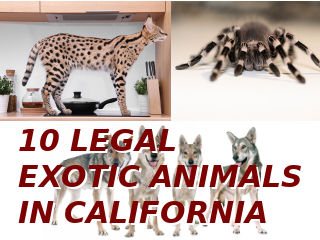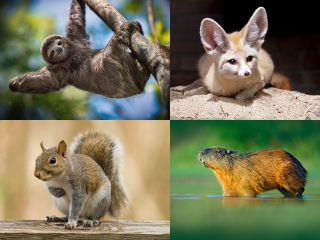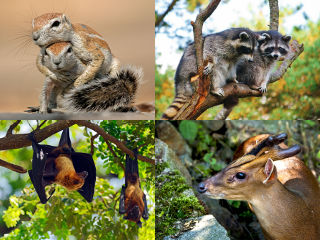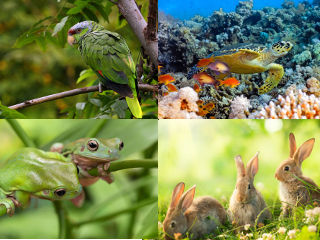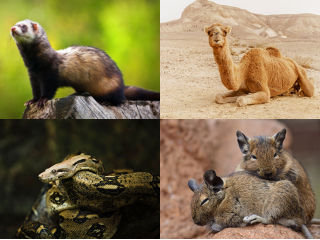Exotic animals sometimes referred to as non-domestic animals, are those that are not commonly kept as pets in Massachusetts. While the state does have laws regulating the ownership of exotic animals, there are still a number of species that are legal to own. Legal exotic animals in Massachusetts include various types of birds, such as parrots, reptiles like snakes and lizards, small mammals like sugar gliders and hedgehogs, and many more.
It is important to note that owning an exotic animal can be a significant responsibility, as these animals often require specialized care and may have specific dietary and housing requirements. It is also important to be aware of any local ordinances or regulations that may further restrict the ownership of exotic animals in Massachusetts.
Mink
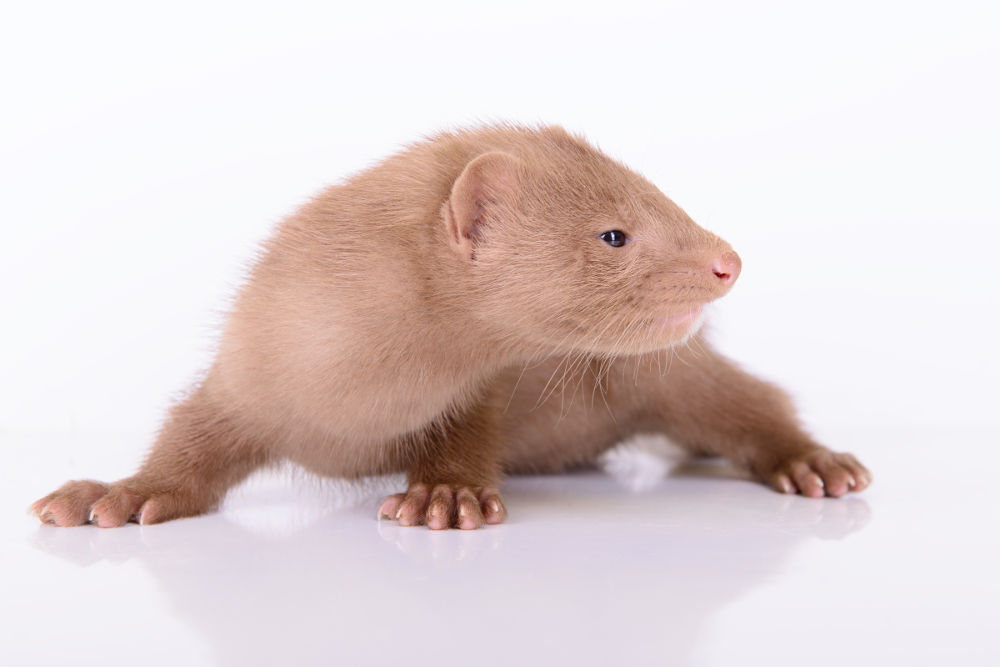
Mink are semi-aquatic mammals that are native to North America and Europe, and they belong to the Mustelidae family, which includes other animals such as weasels, ferrets, and otters. In the wild, mink are found near bodies of water such as streams, rivers, and lakes, and they are known for their excellent swimming ability.
To own a mink in Massachusetts, the mink must have been raised and bred in captivity for at least two generations. Mink are carnivorous animals that primarily eat fish, but they also hunt small rodents and birds. They are most active at dawn and dusk, and they have a high metabolism, which means they need to eat a lot of food in order to thrive. In captivity, they can eat a commercial ferret diet, but this will also need to be supplemented with plenty of raw meat and bones from food sources like chicken, rabbits, and fish. In the wild, mink have a lifespan of about 2-3 years, but they can live up to 8 years in captivity.
Most people and households are not well suited to own a mink. They have complex needs and requirements. And while they may be cute, mink have sharp teeth and claws that they are definitely willing to use against people. Though related to ferrets, they are not described as playful or friendly. To properly care for a mink, a person would need to have lots of outdoor space to provide a large, secure enclosure designed to mimic its natural habitat. Moreover, mink are also known to have an offensive smell or scent that they spray, similar to a skunk. They will spray to mark their territory and when they are alarmed or scared.
Ferrets
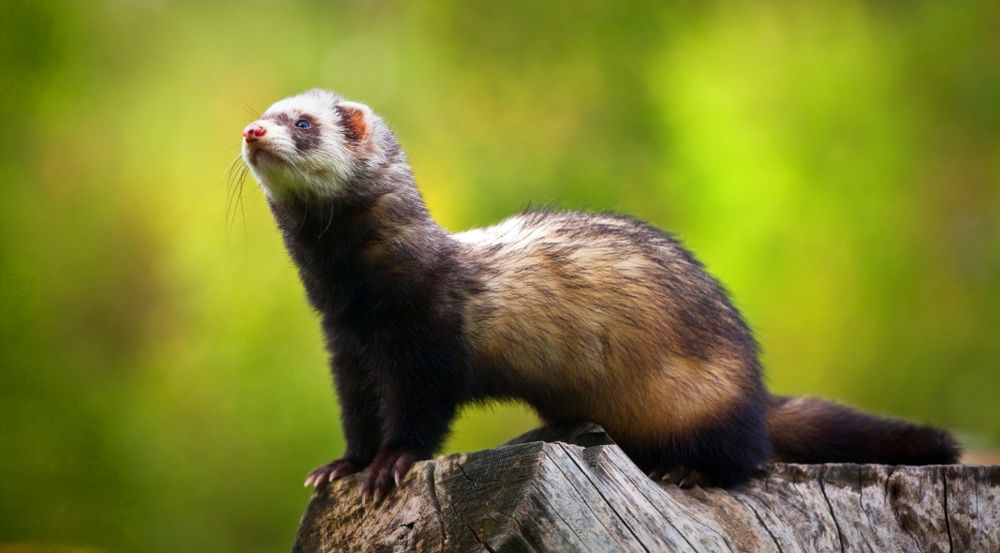
To own ferrets in Massachusetts, owners are legally required to have them spayed or neutered when they reach maturity. Ferrets are domesticated descendants of the European polecat, which is a species of mustelid native to Europe, Asia, and North Africa. Ferrets were likely first domesticated by the ancient Egyptians and were used for hunting, pest control, and as pets. They have also been used for other purposes, such as assisting in the laying of telegraph and telephone cables.
Ferrets were later introduced to other parts of the world, including the United States and Australia, where they have become popular pets. Today, ferrets are bred in a variety of colors and patterns and are kept as pets for their playful and curious nature. Ferrets can make good pets for people who are willing to put in the time and effort to care for them properly. They are intelligent, playful, and energetic animals that can be very affectionate with their owners. However, they do have some specific care requirements that need to be met in order to keep them healthy and happy.
Ferrets are carnivorous animals, so they require a diet that is high in protein and fat. They also need plenty of opportunities to play and explore, as they are naturally curious and active animals. It is important to provide them with a spacious and safe environment to play in, such as a ferret-proofed room or a large cage with plenty of toys and hiding spots. Ferrets are also prone to certain health issues, such as dental problems and adrenal gland tumors, so it is important to have them regularly checked by a veterinarian. They also have a strong smell due to the scent glands in their skin, so both regular grooming and cleaning of their living quarters are necessary to control the odor.
Painted turtle
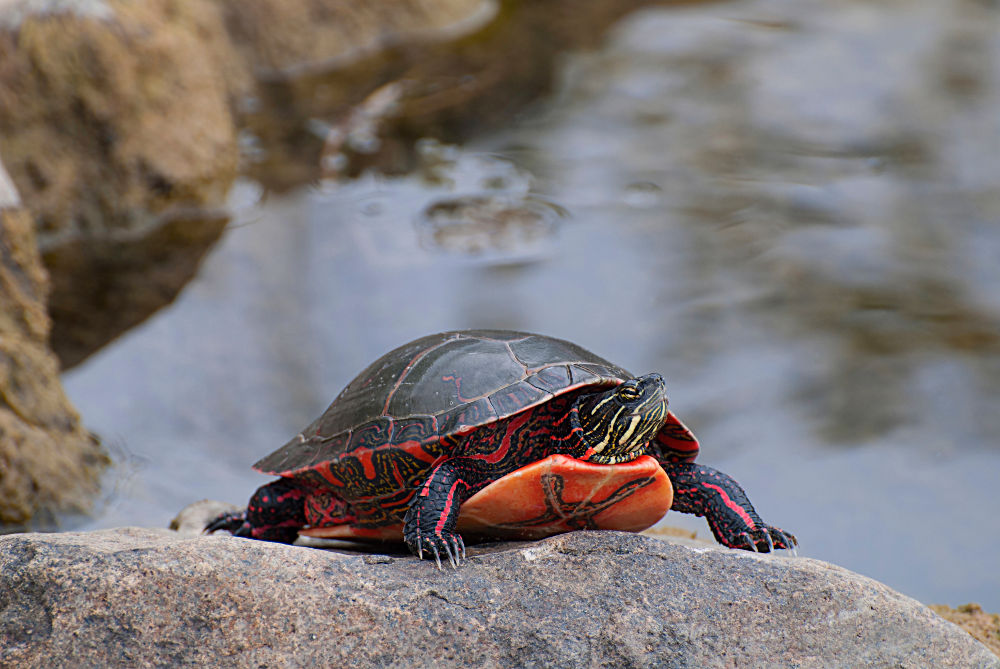
Painted turtles are a species of freshwater turtle native to North America. They are small to medium-sized turtles, with adults typically reaching sizes of 6-10 inches in shell length. Painted turtles are known for their brightly colored shells, which are typically green or olive in color and are marked with yellow and red stripes. They are also known for their distinctive red eyes.
Painted turtles are found in a wide range of habitats, including ponds, marshes, and slow-moving streams. They are omnivorous, feeding on a variety of plant and animal matter, including aquatic plants, insects, and small fish. Painted turtles are also known to bask in the sun, often found basking on logs or other objects near the water's edge.
In the wild, painted turtles can live for many years, with some individuals reaching ages of up to 50 years or more. They are popular pets and are generally easy to care for as long as they are provided with appropriate housing, diet, and environmental conditions.
They require a spacious, well-ventilated enclosure with plenty of room to swim and bask and a basking area with a heat lamp or ceramic heat emitter. A good diet for a painted turtle includes commercial turtle pellets, vegetables, and small amounts of protein, such as worms, crickets, and other insects. It is important to maintain good water quality in the turtle's enclosure by performing regular water changes and using a good-quality filter. Painted turtles also require specific temperatures in order to stay healthy, with the water in their enclosure kept at around 75-80 degrees Fahrenheit and the basking area at around 90 degrees Fahrenheit. A full-spectrum UVB light is also necessary to help them metabolize calcium and maintain healthy shells.
Snapping turtle
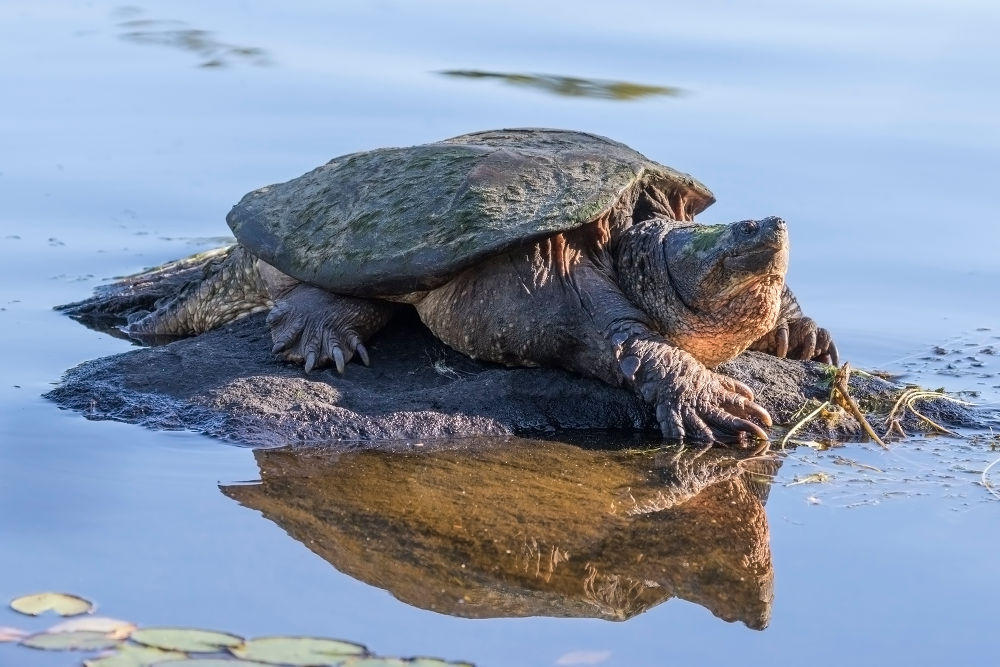
Snapping turtles are large freshwater turtles that are native to North America. They are named for their powerful jaws and sharp beak, which they use to catch and eat a wide variety of prey, including fish, amphibians, and small mammals. Snapping turtles are known for their aggressive behavior and will snap at anything that comes near them, including humans. However, they are generally shy and will retreat into their shells or into the water if they feel threatened. They are also good swimmers and can stay underwater for long periods of time.
Snapping turtles are characterized by their large size, with adults reaching lengths of up to 50 cm (20 inches) and weighing up to 16 kg (35 pounds). They have a distinctive triangular head, a long tail, and a strong, armored shell that protects them from predators. It is generally not recommended to keep snapping turtles as pets. They can grow to be quite large and require a significant amount of space, as well as a specialized habitat that replicates their natural environment. They also require a varied diet and can be difficult to care for, especially for inexperienced pet owners.
In addition, snapping turtles can be aggressive and may bite if they feel threatened. They also have powerful jaws and sharp beaks that can cause serious injury if they bite. That being said, for those who are committed, snapping turtles can make good pets in the way of being more of a look but don't touch kind of pet.
Gray tree frog
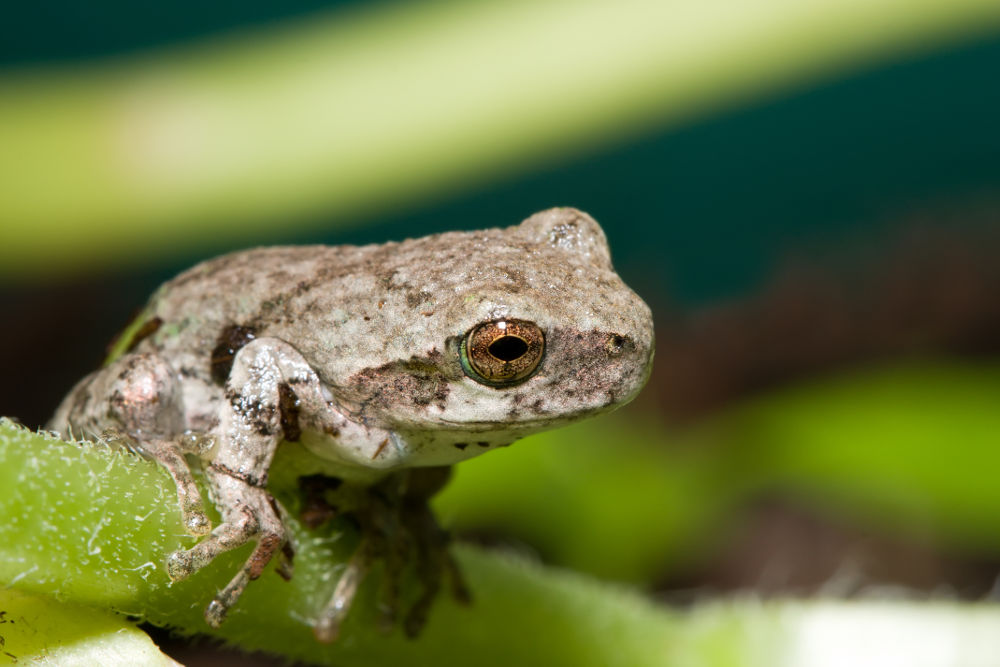
Gray tree frogs are small, arboreal frogs native to much of the eastern United States and southeastern Canada. They are named for their distinctive, mottled gray color, which helps them blend in with the bark of trees and other vegetation. Gray tree frogs are typically active during the warmer months of the year, and they are often found near sources of water, such as ponds, streams, and marshes. They are skilled climbers, and they are known to climb high into trees to avoid predators and to find mates.
Gray tree frogs are known for their ability to change color, although this is not as dramatic as in some other species of frog. They can vary in color from shades of gray to green, depending on their surroundings and the temperature. In colder weather, they tend to be more gray in color, while in warmer weather, they may become more green.
Gray tree frogs are relatively small, with adults reaching a maximum size of about 3.5 inches in length. They have thin, smooth skin and long, slender legs, which they use to grasp onto branches and other surfaces.
Gray tree frogs are not considered to be endangered, and they are common in many parts of their range. They are popular with hobbyists and are often kept as pets. They need a spacious habitat with plenty of climbing opportunities, such as a glass tank or enclosure with branches and live plants. They also need a water dish or a small water area for soaking. It's important to keep the enclosure clean and free of excess moisture, as gray tree frogs are sensitive to high humidity. They require a cool, moist environment to thrive, so the enclosure should be kept at a temperature between 70 and 75 degrees Fahrenheit.
To meet their dietary needs, you can feed them a diet of crickets, worms, and other small insects, dusting the insects with a calcium supplement to ensure the frog is getting enough nutrients. Gray tree frogs are generally docile and can be handled gently, but it's important to handle them with care and wash your hands before and after handling them to prevent the transmission of diseases.
Spiny-tailed (ridge-tailed) monitor
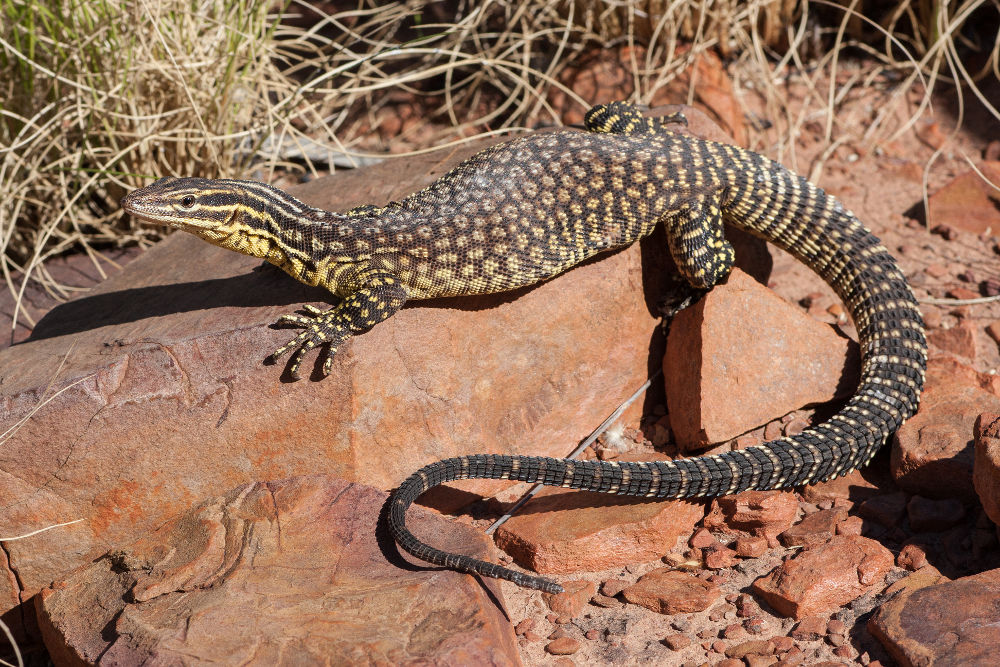
Spiny-tailed monitors, also known as ridge-tailed monitors or pygmy monitors, are a group of small to medium-sized lizards that are native to Australia and New Guinea. They belong to the genus Moniterus, which is part of the family Varanidae, which also includes the well-known Komodo dragon. Spiny-tailed monitors are known for their distinctive spiny tails and robust, stocky build. They have long, powerful legs and claws, which they use for climbing and digging. They are typically tan, brown, or gray in color, with black or dark brown markings.
Spiny-tailed monitors are mostly found in arid and semi-arid regions of Australia and New Guinea, where they live in a variety of habitats, including woodlands, forests, and savannas. They are omnivorous and will eat a variety of insects, small vertebrates, and plant material.
Spiny-tailed monitors are popular as exotic pets, but they can be challenging to care for due to their size and specific habitat and diet requirements. They require a large, secure enclosure with plenty of space to climb and hide, as well as a basking area and a heat source.
Dromedary camel (one-humped)
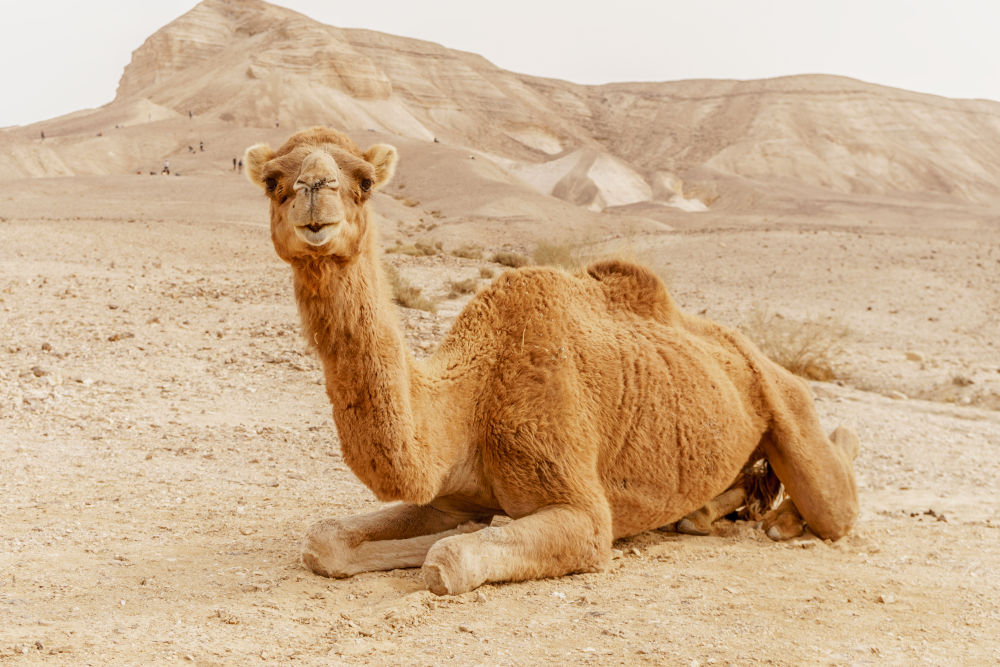
Dromedary camels, also known as Arabian camels, are a type of camel that are native to the dry desert regions of the Middle East and North Africa. They are adapted to living in hot, arid environments and can go for long periods of time without drinking water. Dromedary camels are known for their distinctive humped back, which is used to store fat. This fat is used as a source of energy when food and water are scarce. The hump also helps to balance the weight of the camel when it is carrying heavy loads.
Dromedary camels are well-suited for desert life due to their thick, shaggy coats, which protect them from the sun and help to retain moisture. They also have wide, padded feet that help them to walk on sand without sinking. In addition to being used as pack animals, dromedary camels are also used for milk production and meat. They are considered an important cultural and economic resource in many parts of the Middle East and North Africa.
While not well-suited for being pets per se, some people do enjoy keeping camels as a sort of exotic hobby farm animal. It is important to be prepared to provide for the animal's specific needs. This includes providing a spacious, fenced-in area for the camel to roam and graze, ensuring that the camel has access to clean water at all times, and providing a balanced diet of hay, grains, and vegetables.
It is also important to regularly groom the camel to keep its coat clean and healthy, keep the camel's living area clean and free from debris, and check and trim the camel's hooves as needed. Regular medical care, including vaccinations and parasite control, is also important. It is essential to work with a veterinarian who is familiar with camels to ensure that the animal receives the proper care.
Degu
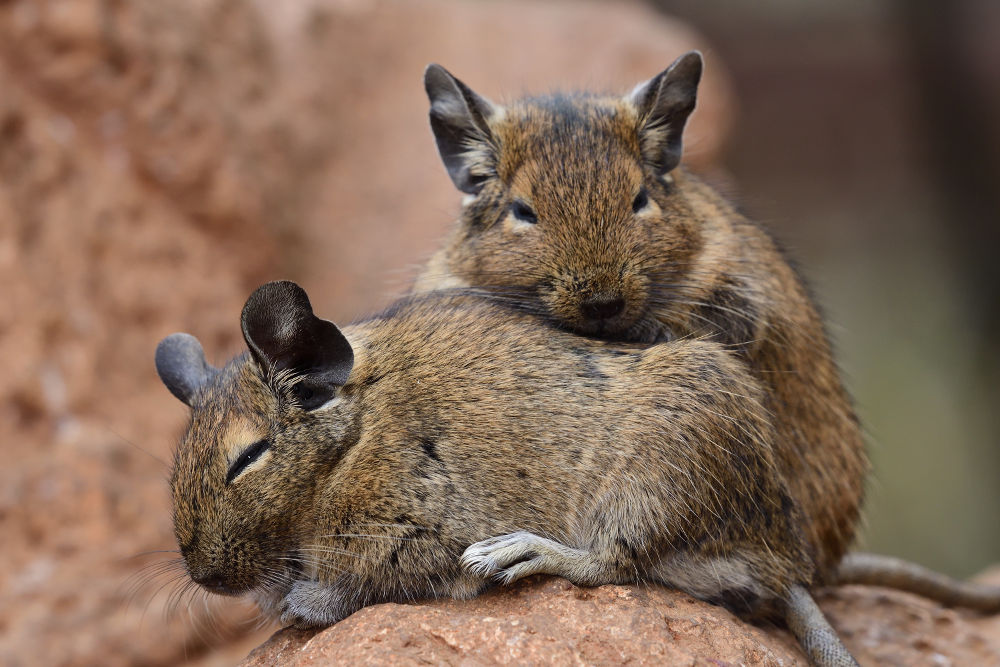
Degus are small, social rodents native to Chile. They are also known as "brush-tailed rats" or "Chilean rats." Degu are about the size of a large hamster and have a thick, soft coat of fur that is usually a light brown or tan color. They have a long, bushy tail and large, dark eyes.
Degus are active and energetic animals that are well-known for their playful and curious nature. They are social animals and should be kept in pairs or small groups, as they thrive on interaction with other degus. In the wild, degus live in large colonies and are known to communicate with each other through vocalizations and body language.
Degus are omnivorous, meaning they eat both plants and animals. In the wild, they feed on a variety of seeds, grains, fruits, and vegetables, as well as insects and small invertebrates. In captivity, they can be fed a commercial degu diet supplemented with fresh fruits and vegetables.
They are popular as pets due to their friendly, playful nature and relatively low maintenance. They are intelligent animals and can be trained to perform simple tricks and behaviors. However, they do require a spacious, well-ventilated cage and should have plenty of opportunities for play and exercise. Degu are not well-suited to life in a small, confined space and can become overweight and inactive if not provided with sufficient opportunities for physical activity. An exercise wheel, as well as plenty of room to run around and play in their habitat, will be essential for keeping them in good shape.
Boa constrictor
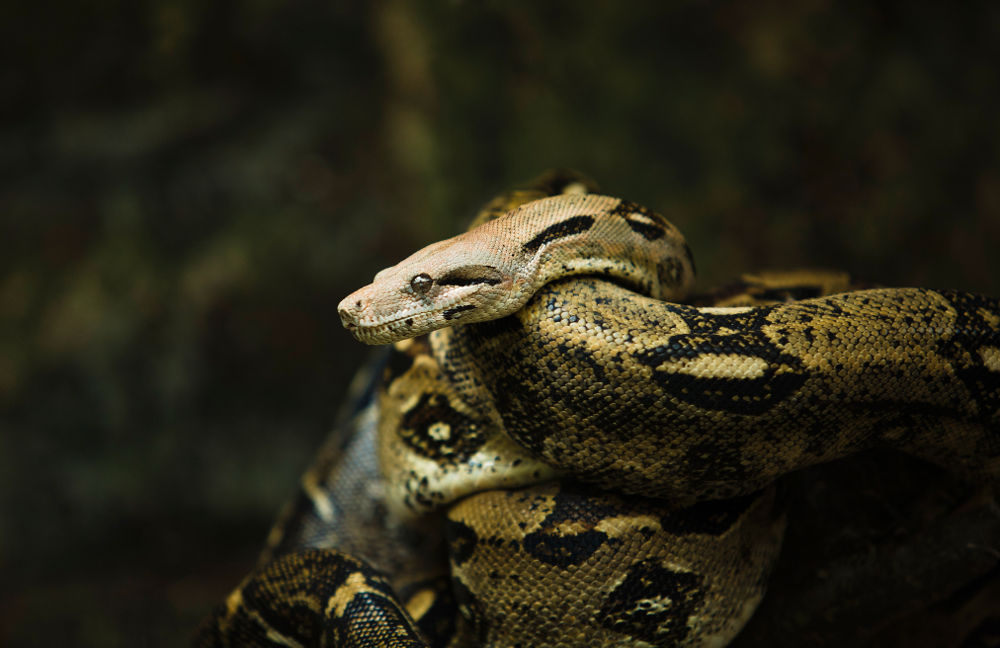
Boa constrictors are large, non-venomous snakes found in the tropical regions of Central and South America. They are known for their ability to constrict, or squeeze, their prey in order to subdue it. Boa constrictors are generally docile and can make good pets if they are properly cared for. Boa constrictors can grow to be quite large, with some individuals reaching lengths of up to 13 feet (4 meters). They have a heavy-bodied, muscular build and are typically brown, tan, or reddish in color with patterns of dark markings. Boa constrictors have a heat-sensitive organ on their head called a pit organ, which helps them locate warm-blooded prey.
In the wild, boa constrictors are found in a variety of habitats, including rainforests, savannas, and swamps. They are skilled climbers and are often found in trees, but they can also be found on the ground. Boa constrictors are carnivorous and feed on a variety of small mammals, such as rodents and birds. If you are considering getting a boa constrictor as a pet, it is important to research and understand the proper care and husbandry requirements for these snakes. They require a large enclosure, a consistent temperature and humidity range, and a varied diet.
Eastern red-backed salamander
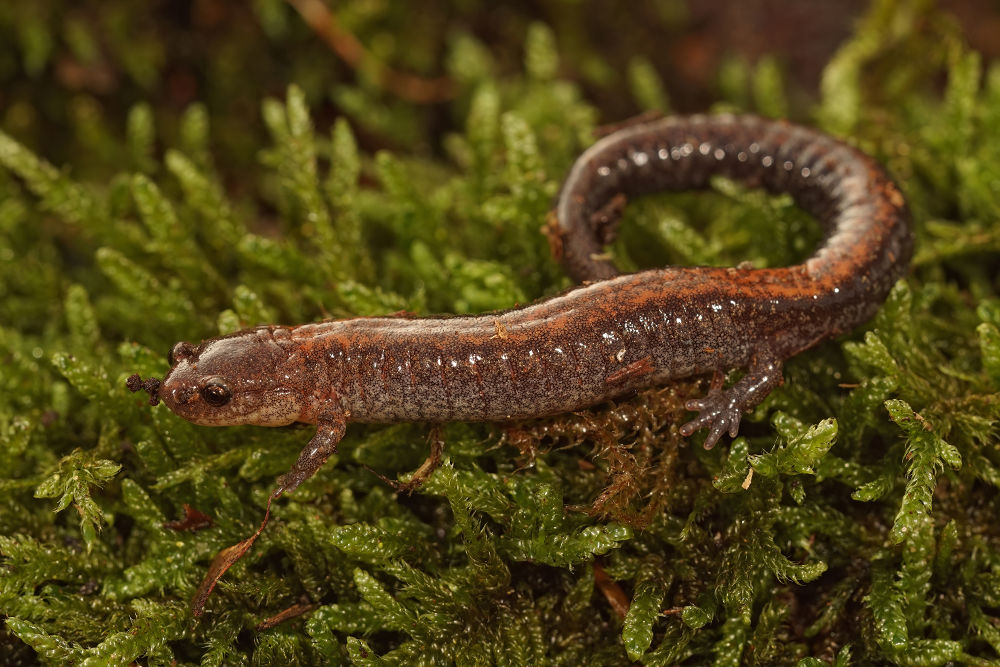
Eastern red-backed salamanders are small, terrestrial salamanders that are native to North America. They are found in a variety of habitats, including forests, swamps, and rocky cliffs. These salamanders are typically about 3-4 inches in length and are characterized by their slender bodies and long tails. They are typically a reddish-brown color with a distinctive red or orange stripe running down their backs.
Eastern red-backed salamanders, like all animals, have their own unique personalities and behaviors. However, it is not accurate to describe them as "mean" or aggressive. These salamanders are generally peaceful and do not exhibit aggressive behavior toward humans or other animals. They are mostly nocturnal and tend to be shy and reclusive, spending most of their time hiding under rocks, logs, and leaf litter during the day. They are carnivorous and feed on insects, spiders, and other small invertebrates. They are also known to eat small amounts of plant material.
Their enclosure should be a terrarium or aquarium that is partially or fully covered and contains a substrate such as moss, coconut coir, or peat moss. The salamanders should be kept at a temperature of 60-70°F and a humidity level of 60-80%. If you are considering getting an Eastern red-backed salamander as a pet, it is important to research and understand the care requirements for these animals.
Things to remember
Exotic animals often require specialized care and can be expensive to maintain. Make sure you have the resources and knowledge to properly care for the animal before adopting it. First and foremost, exotic animals often require specialized housing, such as a large enclosure or habitat. Make sure you have adequate space and resources to provide suitable housing for the animal. Additionally, consider the lifespan of the animal you are considering adopting. Some exotic animals can live for many years and require a long-term commitment.
ConclusionIn Massachusetts, there are several different exotic animals that can legally be owned. There are even some potential benefits to owning an exotic animal, such as companionship and potential education opportunities. Some exotic animals can provide companionship and can be a source of joy and fulfillment for their owners. Moreover, owning an exotic animal can provide an opportunity to learn more about a particular species and its natural habitat. It is essential to keep in mind that while exotic pets may have some potential benefits, it is crucial to carefully consider the potential risks and responsibilities that come with owning one. Exotic animals often have specialized care needs and can be challenging to properly care for.
FAQ
What animals does Massachusetts have?
Massachusetts is home to a diverse range of wildlife species. Some of the animals native to the state include:
Mammals:
White-tailed deer,
Eastern cottontail rabbit,
Eastern chipmunk,
Eastern gray squirrel,
North American beaver,
Red fox,
Coyote,
Black bear (in some regions),
Striped skunk,
Raccoon,
River otter,
American mink
Birds:
American robin,
Northern cardinal,
Blue jay,
American goldfinch,
Black-capped chickadee (state bird),
Red-tailed hawk,
Great blue heron,
Wild turkey,
Peregrine falcon,
Bald eagle
Reptiles and amphibians:
Eastern box turtle,
Common garter snake,
Painted turtle,
Eastern milk snake,
Northern water snake,
American toad,
Gray treefrog,
Red-spotted newt,
Wood frog,
Spotted salamander
Fish:
Atlantic cod,
Bluefish,
Striped bass,
Largemouth bass,
Smallmouth bass,
Rainbow trout,
Brown trout,
Brook trout (state fish),
Marine mammals (found along the coastline):
Harbor seal,
Gray seal,
Humpback whale,
Minke whale,
Fin whale,
North Atlantic right whale
What animal is most likely to kill you in Massachusetts?
The likelihood of being killed by an animal in Massachusetts is very low. However, if we were to identify a potential threat among the wildlife in the state, the animal most likely to be dangerous would be the black bear. Although black bear attacks on humans are rare and they usually avoid people, they are large and powerful animals that could cause harm if they feel threatened or cornered. It's important to remember that such encounters are uncommon, and following proper safety guidelines can help prevent any conflicts with bears.
Other animals, like coyotes, could also pose a threat if they feel threatened, but they tend to be timid and avoid human contact. There are also some venomous snake species in Massachusetts, such as the timber rattlesnake and the northern copperhead, but bites from these snakes are extremely rare and fatalities are even rarer.


